Looking to advance your model training?
You're at the right place because we will discover the "Top 7 Model Training Tools for Maximising Performance"!
Contrary to popular belief, model training in machine learning is not a black-box process.
To ensure that the machine learning (ML) solution continuously performs effectively, developers must hunt deeply into each model to discover the best fit with the data and the business use case.
A model training tool is an interface that allows the developer to deal with the intricacies of machine learning models easily.
But, with so many tools available, how can you choose the best ones? Don't worry; we've got you covered!
In this blog, let’s explore seven powerful tools to take your model training game from zero to hero!
But why is model training so important? The solution, my buddy, is in the statistics.
Properly trained models can increase accuracy by up to 20%. And that's just the tip of the iceberg!
So, if you're ready to unleash the full potential of your models while having a good time, let's get started!
What is Model Training?

Model training teaches a machine learning model to recognize patterns and make predictions based on data. It requires feeding the model labeled data and allowing it to learn from it to improve its accuracy over time.
Model training is a critical phase in machine learning that is required to create trustworthy and accurate models.
Who can benefit from Model Training?
Model training is a transformative process that goes beyond the realm of machine learning experts.
Its potential extends across various sectors, empowering diverse individuals and industries with data-driven insights.
Here are a few compelling examples of who can benefit:
Data Scientists and Researchers
Data scientists and researchers are at the forefront of model training. They leverage this technique to gain insights from large datasets, discover patterns, and develop models that can make accurate predictions.
Model training allows them to extract valuable information and make data-driven decisions.
Business Analysts and Decision Makers
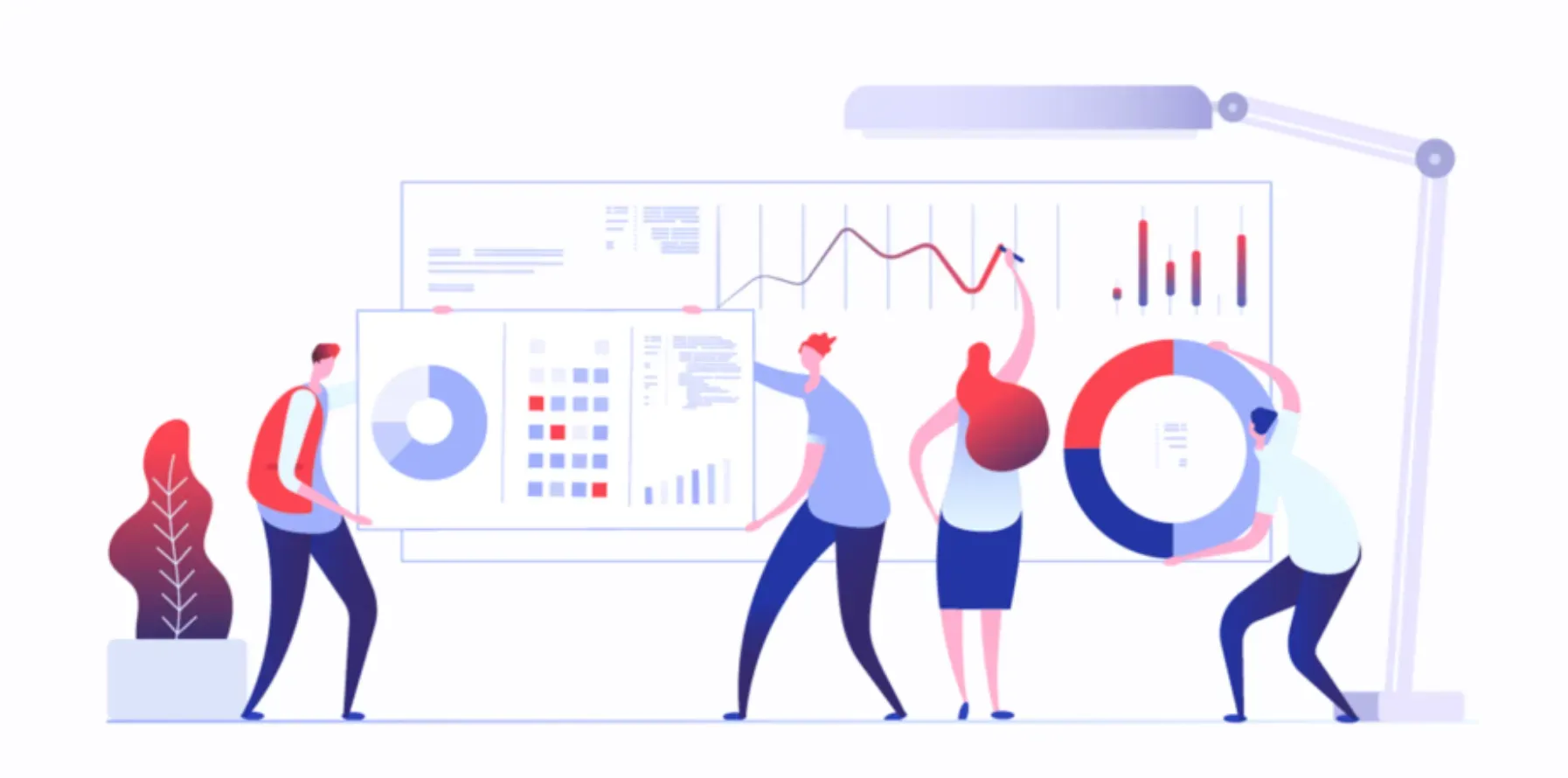
Business analysts and decision-makers can benefit from model training by using machine learning models to optimize business processes, forecast sales, identify customer segments, and detect anomalies.
These models can significantly improve decision-making and help businesses stay ahead of the competition.
Healthcare Professionals
In the healthcare industry, best model training plays a vital role.
From predicting diseases to diagnosing medical conditions and personalizing treatment plans, machine learning models trained with healthcare data can revolutionize patient care, accelerate research, and improve outcomes.
Marketers
Marketers can use model training to analyze client behavior, discover patterns, and design focused marketing efforts.
By employing machine learning models, they may better identify their target demographic and optimize their marketing efforts.
Model training teaches a machine learning model, whereas BotPenguin is an AI chatbot maker that helps to create AI chatbots for different platforms, including WhatsApp, Facebook, Telegram, Website, and Squarespace:
How to Choose the Right Model Training Tools
Certainly, selecting the right tools for model training is crucial to ensure a successful and effective process.
Here are several factors to consider when choosing the appropriate model training tools:
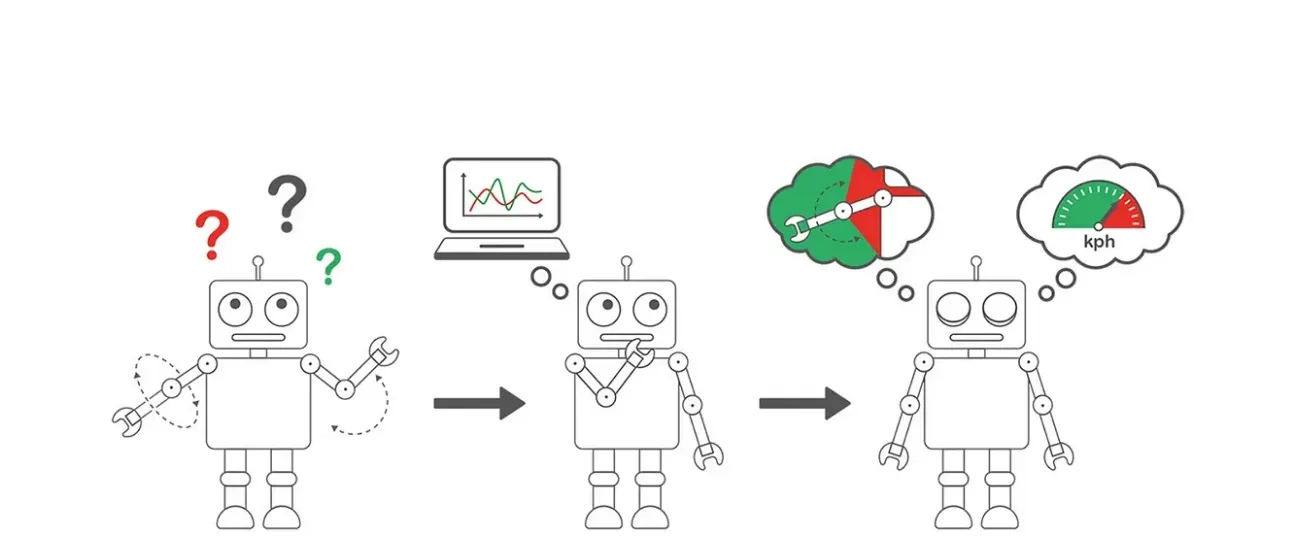
Complexity and Flexibility
Consider the intricacy of your challenge and the level of flexibility you require in your model.
Depending on your needs, you can use simpler models like linear regression or more complicated ones, like deep neural networks.
The goal is to strike a balance between model complexity and interpretability.
Scalability
If you're working with large datasets or foresee rapid growth in data volume, scalability becomes crucial. Choose tools to handle big data and efficiently train models even with increasing data size.
Support and Community
Ensure that the tools you choose have good support and an active community. This will help you troubleshoot issues, find resources, and stay updated with the latest advancements in best model training techniques.
Integration and Deployment
Consider the simplicity of interaction with your existing infrastructure and the various deployment alternatives.
Look for tools that support the programming languages you know and provide deployment options appropriate for your needs, whether cloud-based or on-premises.
Top 7 Tools for Model Training for Maximizing Performance
Machine learning tools will be explored in this section, and some of the most well-liked ones on the market will be covered.
From TensorFlow to scikit-learn and from Microsoft Azure Machine Learning to Amazon SageMaker, we will cover many tools to help you with model training and deployment.
So let's get started!
Tool 1: TensorFlow
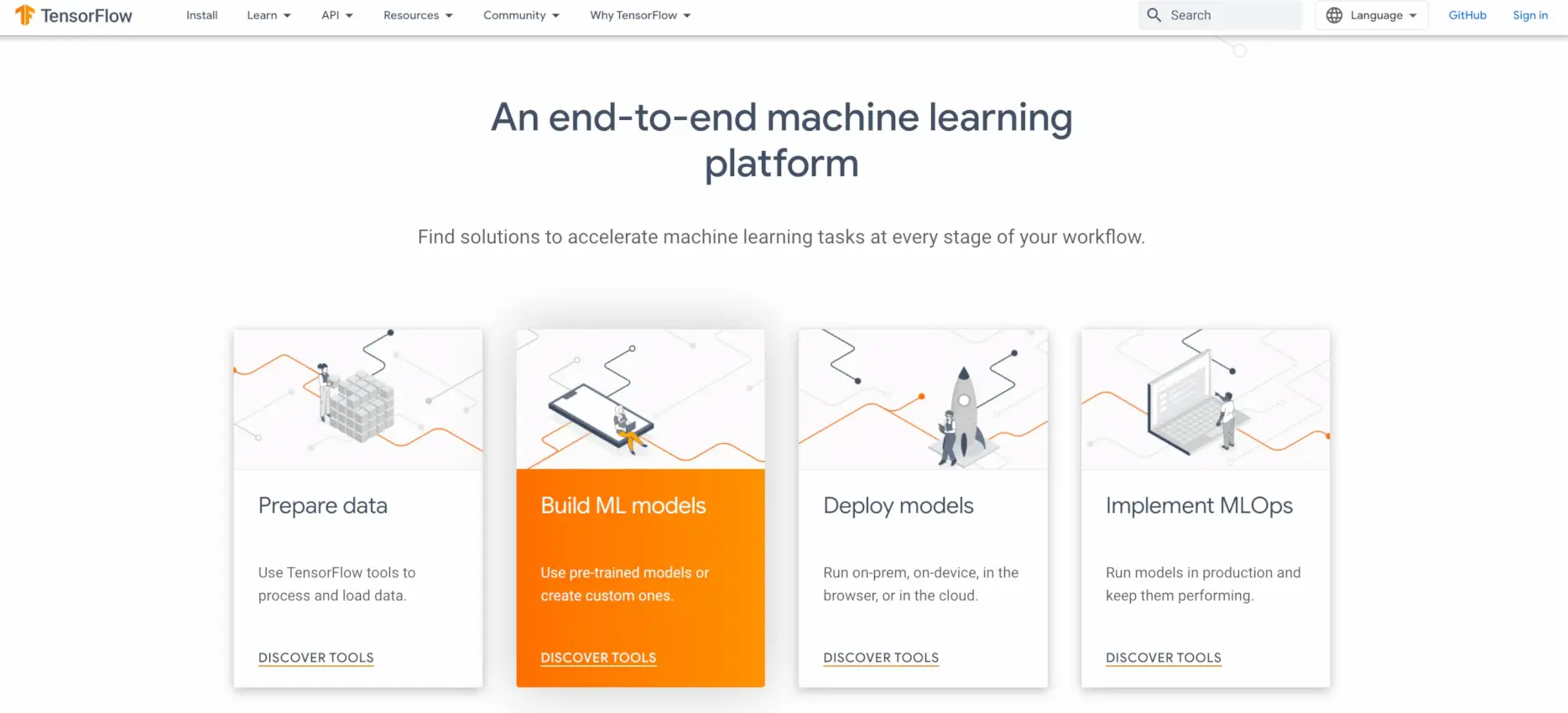
TensorFlow is a Google open-source machine learning framework.
It is intended to be adaptable, scalable, and highly efficient when training and deploying machine learning models.
TensorFlow represents mathematical operations using a computational graph and includes various tools and modules for model construction.
Features and Advantages
- TensorFlow offers a notable level of abstraction, catering to newcomers and machine learning experts.
- It embraces symbolic and imperative programming, allowing users creative freedom in constructing and training models.
- This platform introduces a distributed computing framework, facilitating multi-device and server-based model training.
- Its extensive ecosystem encompasses prebuilt models and versatile tools for diverse applications.
- TensorFlow embraces programming languages like Python, C++, and JavaScript to accommodate various developer preferences.
Use Cases
- Image and speech recognition
- Natural language processing
- Time series forecasting
- Reinforcement learning
Suggested Reading: Tensorflow: Key Features and Advantages
Tool 2: PyTorch
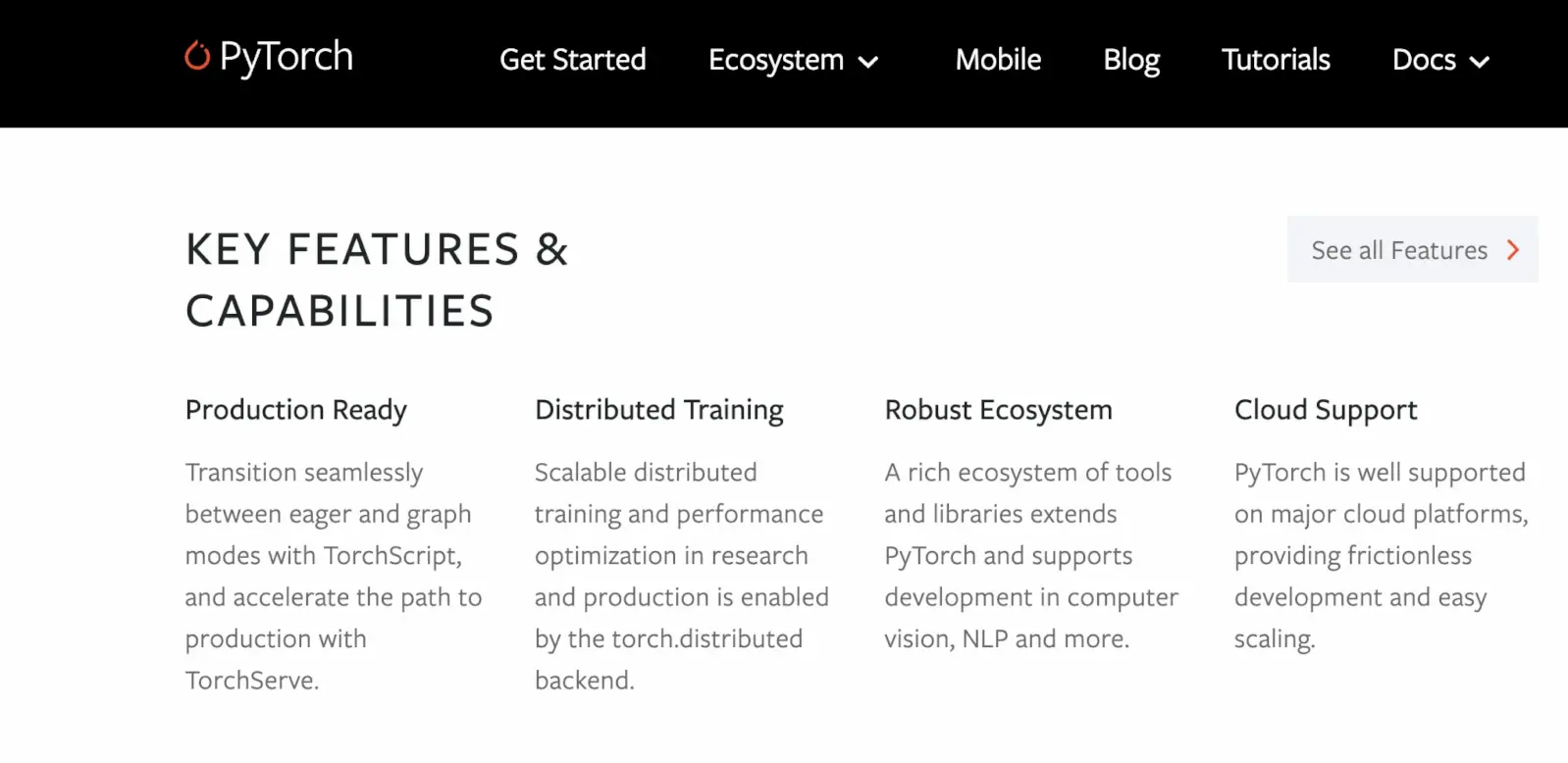
PyTorch is another popular open-source machine learning library that provides a dynamic computational graph. Developed by Facebook's AI Research lab, PyTorch offers a flexible and intuitive approach to model training.
Its simplicity and expressiveness make it a popular choice among researchers and developers.
Features and Advantages
- PyTorch uses dynamic computational graphs, allowing easy debugging and dynamic model behavior.
- It provides a seamless integration with Python, making it user-friendly and accessible.
- PyTorch strongly focuses on GPU acceleration, enabling faster model training and evaluation.
- Its dynamic nature makes it suitable for building complex models with varying input sizes.
- It offers a rich set of libraries and tools for various machine-learning tasks.
Use Cases
- Computer vision
- Natural language processing
- Reinforcement learning
- Generative modeling
Tool 3: Keras
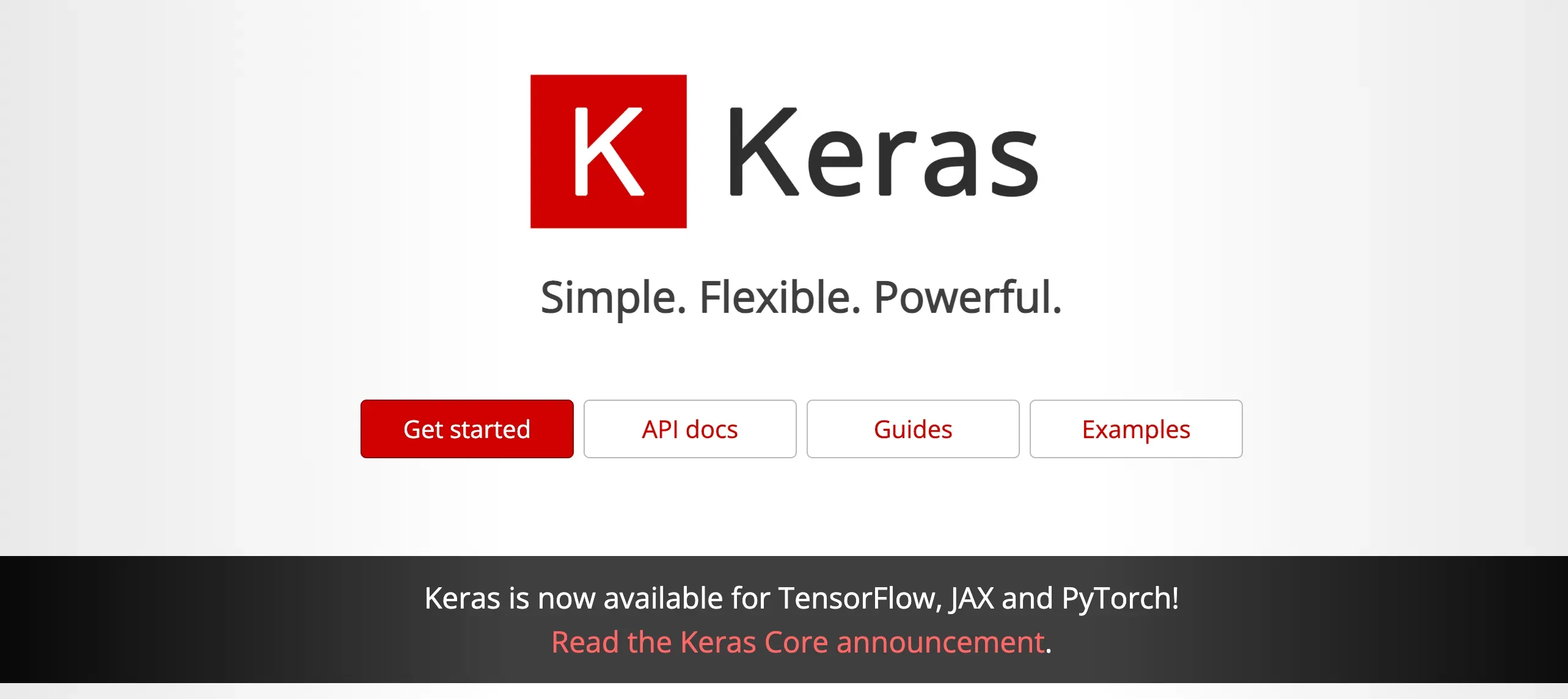
Keras is a Python-based high-level neural network API. It is based on TensorFlow and offers a simple interface for creating and training deep learning models.
Keras is designed to be simple, modular, and extendable, allowing users to build strong models with minimal coding.
Features and Advantages
- Keras offers a user-friendly high-level abstraction that simplifies deep learning initiation for novices.
- Boasting a robust community and comprehensive documentation, it assures strong user assistance and valuable resources.
- Keras backs convolutional and recurrent neural networks alongside diverse network architectures.
- Its tight integration with TensorFlow enables harnessing its rich toolkit and ecosystem seamlessly.
- Keras prioritizes code clarity and conciseness, making it a favored choice for researchers and developers.
Use Cases
- Image classification
- Object detection
- Sentiment analysis
- Text generation
Tool 4: Scikit-learn

Scikit-learn is a popular Python machine-learning library. It comes with many tools for data preprocessing, model selection, evaluation, and deployment.
Scikit-learn is built on NumPy, SciPy, and Matplotlib, providing a rich ecosystem for machine learning tasks.
Features and Advantages
- Scikit-learn has an easy-to-use interface and a consistent API, making it simple to learn and use.
- It contains various classification, regression, clustering, and dimensionality reduction techniques.
- Scikit-learn provides a variety of utilities for data preprocessing, feature engineering, and model evaluation.
- It has excellent documentation and a large community, ensuring good user support and resources.
- Scikit-learn supports integration with other popular libraries such as pandas and TensorFlow.
Use Cases
- Classification and regression
- Clustering and dimensionality reduction
- Model selection and evaluation
- Anomaly detection
Tool 5: Microsoft Azure Machine Learning

Microsoft Azure Machine Learning is a cloud-based service that streamlines the machine learning process from start to finish.
It provides a scalable and collaborative environment for designing, training, and deploying machine learning models on the Azure platform.
Features and Advantages
- Azure Machine Learning integrates seamlessly with other Azure services, allowing for easy data management and model deployment.
- It provides various tools for data preparation, model training, and model evaluation within a single platform.
- Azure Machine Learning supports various programming languages, including Python and R, making it accessible to many users.
- It offers automated machine learning capabilities, allowing users to quickly build and deploy models with minimal coding.
- Azure Machine Learning provides scalable computing resources and distributed training options for handling large datasets and complex models.
Suggested Reading: Machine Learning vs Deep Learning vs AI
Use Cases
- Predictive maintenance
- Fraud detection
- Demand forecasting
- Churn prediction
Tool 6: Google Cloud AutoML

Google Cloud AutoML is a machine learning product suite that makes designing and deploying bespoke machine learning models easier. It provides tools and pre-built models to help automate the training and deployment of machine learning models.
Features and Advantages
- Google Cloud AutoML provides a user-friendly interface requiring minimal machine learning expertise.
- It offers various pre-trained models for image classification, text classification, and entity extraction, allowing users to get started with AI applications quickly.
- Google Cloud AutoML provides various tools for data preparation, model training, and model evaluation.
- It integrates well with other Google Cloud services, enabling seamless model deployment and scalability.
- Google Cloud AutoML supports Python and REST APIs, making it accessible to developers with different programming backgrounds.
Use Cases
- Image recognition and classification
- Natural language processing
- Data extraction and entity recognition
- Sentiment analysis
Tool 7: Amazon SageMaker

Amazon SageMaker is a fully managed machine learning service that Amazon Web Services (AWS) provides. It includes a full set of tools for developing, training and deploying machine learning models.
With SageMaker, users can quickly and efficiently tackle complex machine-learning tasks.
Features and Advantages
- Amazon SageMaker provides a comprehensive set of tools for data labeling, model training, and model deployment.
- It provides a scalable infrastructure for automatically performing basic tasks such as data storage, model training, and hyperparameter optimization.
- The machine learning frameworks that SageMaker supports include TensorFlow, PyTorch, and scikit-learn.
- It integrates well with other AWS services, enabling seamless data ingestion, model deployment, and monitoring.
- Amazon SageMaker offers pre-built notebooks and a range of sample codes for accelerated development.
Use Cases
- Forecasting and time series analysis
- Recommender systems
- Fraud detection
- Image and object recognition
Conclusion
That was certainly a ride, wasn't it? We covered a lot of terrain and discussed some intriguing model training tools.
There are several possibilities, each with particular benefits and features, ranging from TensorFlow and PyTorch to scikit-learn and Keras.
And remember that cloud-based services like Microsoft Azure Machine Learning, Google Cloud AutoML, and Amazon SageMaker offer simplified and efficient ways of developing, training, and deploying models.
Whether you're a beginner or an expert, these tools can help you maximize your performance and step up your game in machine learning.
Frequently Asked Questions (FAQs)
What are the top tools for model training in machine learning?
Discover the industry-leading tools like TensorFlow, PyTorch, and scikit-learn that can enhance model performance and accelerate the training process.
How does TensorFlow contribute to maximizing model performance?
TensorFlow's flexible architecture and distributed computing capabilities enable efficient training of complex models, leading to better performance and scalability.
Why is PyTorch considered one of the best tools for model training?
PyTorch's dynamic computation graph and extensive neural network modules empower researchers and developers to build high-performance models easily.
How can scikit-learn improve model performance?
Scikit-learn offers various algorithms and utilities for data preprocessing, feature selection, and model evaluation, optimizing model performance across diverse datasets.
What role does Keras play in maximizing model performance?
With its user-friendly API and seamless integration with TensorFlow, Keras simplifies model training, enabling quick experimentation and achieving impressive results.


